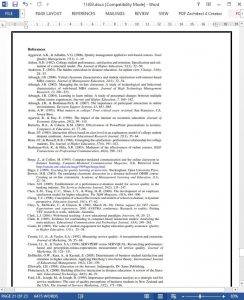The demand for e-learning in higher education is rising, competition is increasing, and universities are investing significant resources towards improving the quality of their e-learning offerings. Thus, effective quality measures for e-learning are urgently required. With the aim of following the total quality management practices of raising students’ satisfaction and continuous improvement, a performance-evaluation model was applied in a sample of business students. The application of this model was useful for selecting the quality items that most urgently require improvement to achieve student satisfaction and for identifying the items of surplus resource investment, thereby helping to provide the means to minimise resource wastage. This way, an effective and efficient improvement plan to enhance the efficient use of resources in e-learning and to meet an adequate level of quality was established.
Introduction
The subject of quality in higher education has received increasing attention. This study agrees with Ruben (1995) that generally speaking, it is a service industry, one that every day is more and more exposed to globalisation processes (O’Neill & Palmer, 2004) and increasingly intense competition and expectations from stakeholders. Never before have they had to focus on asking what society values in the skills and abilities of their graduates, nor have they been concerned with asking their students how they feel about their educational ‘experiences’ (Ford, Joseph, & Joseph, 1999). As a consequence, universities and colleges are placing increasing emphasis on improving the quality of their educational services (Kuo & Ye, 2009).
Conclusions
At the heart of all quality initiatives there is an emphasis on the use of data to make decisions associated with quality improvements (Wild & Hope, 2003). In this study, the data from students’ perceptions of satisfaction and importance were transformed into recommendations to improve resource investment in e-learning programmes in higher education.
The first contribution of this research is the use of a model to measure quality in e-learning that is not focused exclusively on evaluating quality through selected attributes in terms of the students’ satisfaction, with the aim of improving those attributes with the lowest levels of satisfaction. Low-quality attributes should not be the only consideration when designing improvement plans. The approach employed is more ambitious because it suggests taking actions to improve the attributes that have low satisfaction levels and are important to students at the same time. Furthermore, the performance-evaluation model employed is a useful tool for selecting quality items that most urgently require improvement to achieve student satisfaction in e-learning and for identifying items of surplus resource investment, thereby helping to provide the means to minimise resource wastage. The information gathered through this approach helps in the drafting of an effective and efficient improvement plan to enhance the efficient use of resources in e-learning and to meet an adequate level of quality.











